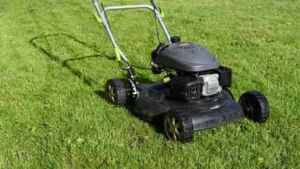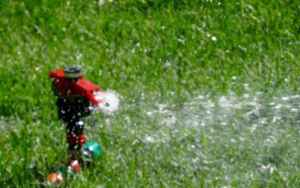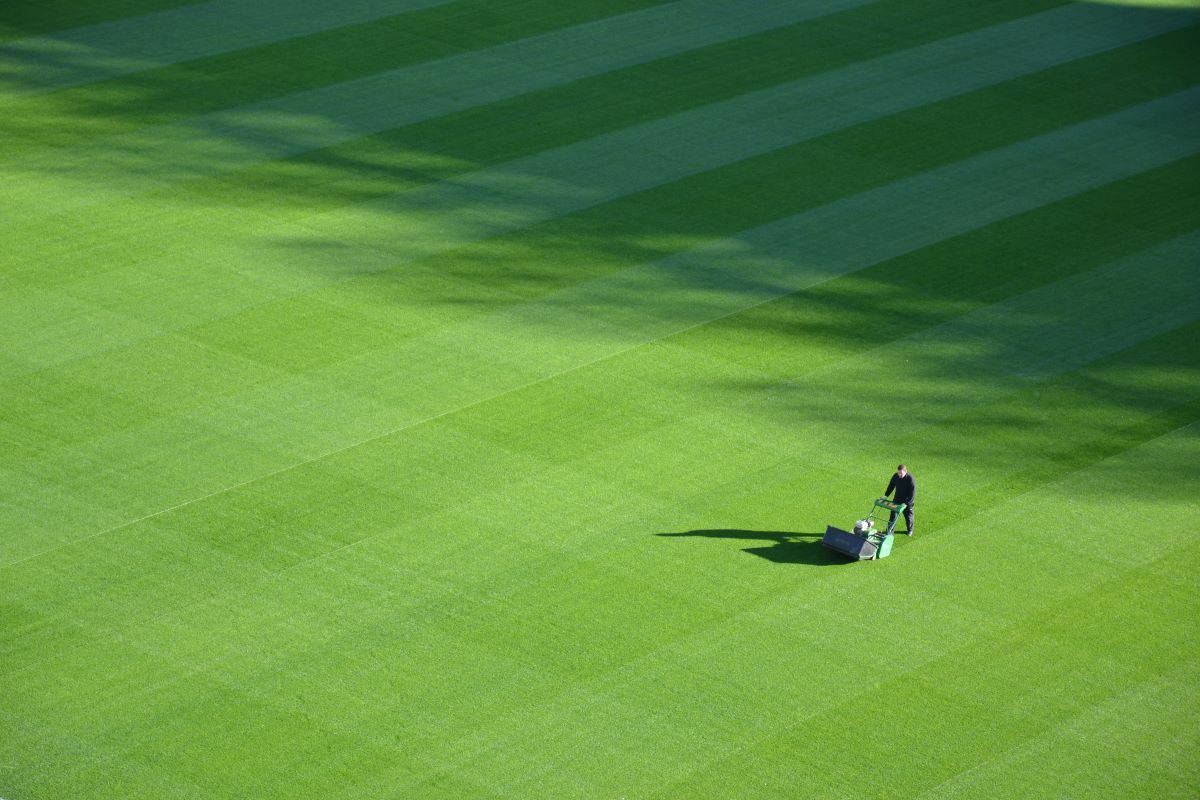This is a common question. The general rule of thumb is to wait for 24 hours before you mow. There are new fertilizers and ways to distribute them throughout the yard. The reason for this is that many variables affect how long you should wait before mowing such as the type of fertilizer used, the season, and weeds growing in the yard.
After I Fertilize My Lawn How Long Do I Need To Wait Until I Mow?
 Extreme weather, foot and pet traffic all contribute to the deterioration of your lawn if you don’t maintain it properly. Thick, green grasses require a lot of constant care to remain healthy with no unattractive brown barren areas appearing while neglecting them is dangerous. Keeping your lawn well-fertilized twice to three times a year is one of the most effective methods to guarantee that the soil’s nutrients are balanced and your grass stays strong. To keep the freshly added nutrients in the tiny ecosystem, you should time your lawn mowing carefully after fertilization.
Extreme weather, foot and pet traffic all contribute to the deterioration of your lawn if you don’t maintain it properly. Thick, green grasses require a lot of constant care to remain healthy with no unattractive brown barren areas appearing while neglecting them is dangerous. Keeping your lawn well-fertilized twice to three times a year is one of the most effective methods to guarantee that the soil’s nutrients are balanced and your grass stays strong. To keep the freshly added nutrients in the tiny ecosystem, you should time your lawn mowing carefully after fertilization.
Mowing First Can Help
Mow at least once a week during the growing season. If you fertilize immediately after mowing, waiting a week before mowing is perfectly acceptable. Don’t allow the grass to get out of hand by waiting longer than a week after fertilizing.
- The extra nutrients enhance the grass’s growth potential.
- Most lawn types of grasses do not adapt well when you cut more than one-third of the blade’s length in a single mowing session.
- Mow frequently and often for the healthiest lawn possible.
- Fertilizer after mowing takes away the guesswork from the fertilization process. This will give the grass at least make sure the fertilizer has been properly absorbed and watered.
Give your lawn a natural boost after mowing and fertilizing it by leaving the clippings on the grass. They will decompose over time, releasing extra organic nutrients and water back into your soil. What’s not to like about that nutrient boost? You did not even have to shell out for an extra fertilizer application. Sometimes the best things are free.
Using Liquid Fertilizers
After application, the fertilizer may remain on the grass blades for a short time even after it has been mixed with water for soil absorption. The fertilizer can remain on the grass blades for up to 24 hours after application.
- If you apply liquid fertilizer, mow the lawn once it has fully dried. It might take a few hours in high temperatures to completely dry.
- Wait 24 hours after applying fertilizer to ensure that the fertilizer is properly absorbed by the grass and soil structure.
Again, waiting 24 hours is the best rule in keeping with fertilizing. Once it dries, mow your lawn as soon as possible if the grass is overgrown. This will help your lawn grow strong and healthy.
Using Granular Fertilizers
When you have dispersed granular fertilizer with a spreader or by hand, it allows you to see exactly where you’re applying them. You must water the grass as soon after distributing the granules as possible. This will help them to be absorbed into the ground.
- You can now water immediately after.
- Thoroughly watering the lawn covers all of the grass.
- It ensures that the fertilizer is well absorbed by the soil rather than sticking to the grass blades.
As a result, lawnmowers set at tall cutting lengths, like 1 or 2 inches, cannot disturb the fertilizer below.
During Mowing Season…
Mow your lawn at least once a week. Try fertilizing after mowing. When you wait a full week until you mow again is an acceptable weighting period. It will help to make sure all of the treatment has had a Remember, do not allow grass to develop unchecked if you wait longer than a week after applying fertilizer.
- Maintain your lawn regularly and mowing it frequently helps achieve the healthiest grass.
- Achieving this is beneficial because most grasses do not react well to being cut more than one-third of their blade’s length at once.
- Trimming your grass regularly and multiple times is important for optimum health.
Water the grass immediately after applying liquid fertilizer. This helps the product absorb into the ground. The consistent applications of fertilizers, mowing, and watering will pretty much guarantee a healthy yard.
 How Hard Is It For Fertilizer To Break Down?
How Hard Is It For Fertilizer To Break Down?
When you have put fertilizer on your grass and evenly distributed it, the next step is to wait for the granular fertilizer to dissolve. The majority of people would be wondering when we will see some stunning results. This will rely on how long it takes for the granular fertilizer to dissolve.
Differences In Processing A Granual Or Organic Fertilizer In Your Lawn
There’s never been a better way to top your neighbors than with a lush green lawn right in front of your house. However, having a healthy lawn entails much more than simply grass.
- It is critical to nurture your lawn in the same manner you would a kid.
- You understand that it will require a balanced diet to grow strong, flourish, and even battle illnesses.
- Your lawn is like a newborn parent to you. It is necessary to decide on a fertilizer that will enable this to happen.
- Like a parent, most people do not want it to grow too fast and develop as it should.
- Children are the more impatient ones and want results faster than they naturally would occur.
- As most people have seen children can make big messes, and they can even exert more force than adults.
Fertilizer is a carefully calculated approach to achieving an idealistic goal. This means that every aspect of your lawn will be in a state of perfection throughout the year.
Timing For Granular Fertilizer to Work?
There are a few factors to consider. First, are you using natural slow-release or synthetic fast-release fertilizers? A rapid-release synthetic fertilizer is frequently chosen by people seeking a quick remedy for their lawns since the results may be seen in a few days.
- Organic fertilizers may take anywhere from two to six weeks to provide any result.
- Most people would think that only a lunatic would go with the slow-release technique rather than the quick-release option.
- There are a few things that might persuade you otherwise.
Organic Fertilizers Take A Lot Longer to Decompose- Why?
Organic fertilizer contains nutrients that will help your grass grow. These include necessary nitrogen, phosphorus, and potassium in addition to micronutrients, potash, and microorganisms.
- All of these elements are derived from organic sources, such as bone meal, blood meal, and fish emulsion.
- To some people, this may not sound appealing at all, but your grass welcomes it with open arms.
- Unlike quick-release lawn fertilizer, organic substances do not dissolve into your grass.
Consider the food scraps you put in your compost box or don’t. It’s a little repulsive, but your lawn is delighted to receive a big helping of decomposing organic waste. Remember, you are not throwing garbage on your lawn. It is decomposing and becoming a fertilizer.
Granular Fertilizers
You should apply a slow-release fertilizer four times a year if you are utilizing one. Apply fertilizer in late and early spring as well as late and early fall, according to a general rule of thumb. In most cases, summer is too hot.
- You can also use slow-release fertilizer with a delay of four to six weeks.
- Water your lawn a day or two before applying to prepare it for decomposition if you’re using a slow-release fertilizer.
- If there is no rain in the forecast, water your lawn after fertilizing it.
Synthetic types of fertilizers need to be applied more often and, most importantly, children and pets must be kept off of it for 24 hours after application. There is not one family that would want their dog or small child to get a mouthful of turf that has been sprayed with synthetic fertilizers.
What Is The Length Of Time Fertilizers Last In The Soil?
Slow-release and organic fertilizer take six weeks or more to decompose into the soil. Maybe a better question to ask is how long does it last in the soil?
- Organic, granular fertilizer may provide nutrients to your lawn for anywhere from three months to 10 years after application.
- Now that’s a lot of green for your buck.
One of the best things you can do is get a soil sample to check what is needed or what isn’t lasting in your soil. This is where a professional can help you know how often you need to fertilize and what your lawn needs exactly.
 Summary
Summary
Knowing when to mow your grass is important when trying to make your grass as healthy as possible. Overall, it is better to mow and then fertilize your lawn. There will be no guessing when to mow afterward. It is important to remember that the length of time to mow after fertilizing will vary depending on whether or not you are using organic or synthetic fertilizer.
If you are using organic fertilizers, it is standard to wait six weeks before mowing. If you are using quick-release synthetic fertilizers, it is best to wait 24 hours before mowing. This article helps you understand the length of time to fertilize your grass, knowing when to mow after fertilizing, and which fertilizer bests suit your needs.

